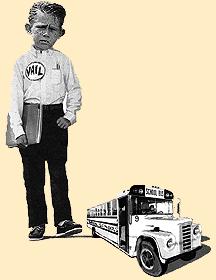WHAT MAKES THE Southern Arizona Home Builders Association happy also worries a rural school superintendent on Tucson's southeast side. That's because the housing boom there is beginning to take its toll. The victim: the tiny Vail School District.
When the bell tolls to start the 1996 school year, the district's six grade schools will be short by a total of 18 to 20 elementary classrooms, says Vail School Superintendent Calvin Baker.
That kind of shortage in a district like TUSD would be a manageable problem. In a small, rural district like Vail, it's a calamity.
In 1988 Vail's kindergarten-through-eighth-grade enrollment was about 500 students. By 1995 the district's enrollment had tripled to almost 1,600. Baker says the population surge occurred over the last two years, when enrollment jumped 35 percent each year.
 He adds the state's funding formula for schools allows his district
to receive supplemental operating funds, but it doesn't provide
a single dime for capital expansion. Funds to build needed classrooms
must come from the district's locally assessed tax base, which
plummeted when the University of Arizona snapped up the old IBM
site, thus taking it off the district's tax rolls.
He adds the state's funding formula for schools allows his district
to receive supplemental operating funds, but it doesn't provide
a single dime for capital expansion. Funds to build needed classrooms
must come from the district's locally assessed tax base, which
plummeted when the University of Arizona snapped up the old IBM
site, thus taking it off the district's tax rolls.
The loss of IBM dropped the district's assessed valuation from $125 million to $75 million in one year. This revenue loss, plus an explosion in the student population, has left the district reeling.
The huge jump in student enrollment has come from a burst of new housing sales in City of Tucson subdivisions such as Rita Ranch and from housing sales in Vail, the Rincon Valley and areas nearby.
Moreover, a recently passed state law now requires any district in which high schoolers reside to pay $4,000 in tuition for each student living in the district but attending school elsewhere. And the Vail School District has no high school.
Chris Monson, president of the massive Rocking K "new town" development project proposed for the southeast side, told The Weekly earlier in the year the area is booming. "Forget the northwest," he said, "it's already crowded. The hot spot to build is southeast."
With Microsoft soon to move a significant number of out-of-town support staff into its new digs at the UA's old IBM site, and the City of Tucson recently annexing 16.4 square miles of vacant turf nearby, the southeast side is indeed beginning to look like a developer's wet dream.
School districts can't impose impact fees on new development; but if they could, says Baker, the Vail School District would be among the first asking homebuilders to pay their fair share.
Baker concedes that without a commercial base such as the old IBM site on the tax rolls, his district's students and teachers will continue to suffer.
When the billion-dollar Rocking K development becomes a reality, what will become of the Vail School District? The Rocking K group has made arrangements with Vail officials to donate land for future school sites. And Baker says that's great--except the district doesn't have the money to build those new schools.
In the meantime, Baker isn't even sure how he and the school board will deal with their most immediate problem--the need for those 18 to 20 more classrooms.
"Maybe we can find a way to put up some temporary units," he says.





